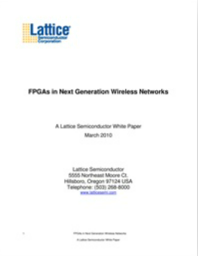FPGAs in Next Generation Wireless Networks
In addition to voice connectivity, digital cellular wireless networks such as GSM and its enhancement, GSM-EDGE, can now provide increased data speeds up to a (theoretical) limit of 384Kbps. Third generation mobile networks, such as CDMA2000 and WCDMA or UMTS (Universal Mobile Telecommunications Standards) and TDSCDMA (China only) are currently being deployed worldwide.
These systems offer services such as video streaming, Internet browsing and, by using a technique called High Speed Packet Access (HSPA), they can in theory deliver downlink speeds up to 14.4Mbps.
Download this whitepaper to learn more.
Read More
By submitting this form you agree to Lattice Semiconductor Corporation contacting you with marketing-related emails or by telephone. You may unsubscribe at any time. Lattice Semiconductor Corporation web sites and communications are subject to their Privacy Notice.
By requesting this resource you agree to our terms of use. All data is protected by our Privacy Notice. If you have any further questions please email dataprotection@techpublishhub.com
Related Categories: Cellular, Communication, Embedded, Power, Processors

More resources from Lattice Semiconductor Corporation
MachXO PLDs in System Control Designs
Temperature measurement, current monitoring, power supply sequencing, fan control and fault logging are typical board control functions used in com...
High-Speed SERDES Interfaces In High Value FPGAs
Lattice Semiconductor has introduced two low cost FPGA families with SERDES, the LatticeECP2M, introduced in 2007, and the most recent family, the ...
POWER CONSIDERATIONS IN FPGA DESIGN
Power has always been a design consideration. Traditionally, though, a lower priority has been assigned to power than to most other variables (spee...
